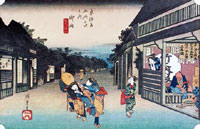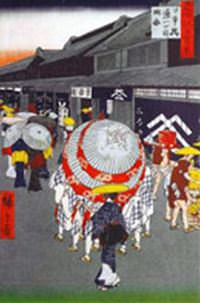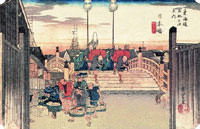Culture
Tokugawa Edo era

Tokugawa Ieyasu was appointed shogun- military administrator- in 1603 by the emperor. One of the most important acts of the Tokugawa regime in its quest to achieve total control of the county was to implement the Sankin kotai system. This demanded that all Daimyo in Japan spend at least one year out of two in Edo. Their wives and children were to remain in Edo. This dislocating ransom policy made it difficult for ambitious to usurp the Tokugawa. Society was made it hierarchical, comprising the nobility, that had nominal power- The Daimyo and their Samurai- , the farmers, the artist and merchants. Class dress, living quarter and even manner of speech were all strictly codified, and interclass movement prohibited.
When Ieyasu died in 1616, his ashes were laid to rest in Chubu before being moved to Nikko. Generation of Tokugawa made improvement to his shrine, transforming it into one of the grandest in all Japan. In 1638, concerned that missionaries were gaining too much power, Ieyasu's grandson, Tokugawa Iemitsu, massacred a number of Kyushu Christians and closed the country to almost all foreign trade. This radical isolation policy, Known as Sakoku, was to remove Japan from the world stage for nearly three century. This sudden change led to the rapid growth of the small town of Edo. By the 17 century, the population had grown to more than one million, making it the largest city in the world.

Meanwhile, the castle like social imposed by Tokugawa rule divided Edo into high city - Yamanote- region and a low city - Shitamachi- region. The higher Yamanote area was home to Daimyo and their Samurai, while the lower orders of Edo society were forced into the lower-lying Shitamachi area. Shitamachi residents lived in squalid conditions, usually in flimsy wooden structure with earthen floors, Grate conflagrations often swept across their shantytowns. These fires were known to locals as Edo-no-hana or flowers of Edo. Another of Edo that had le its mark on today's Tokyo was the division of the city into town according to profession. Even today it is possible to stumble across small enclaves that specialize in particular wares. Most famous are Jinbocho,-the Book shop area, Kappabashi- the plastic foods and kitchen supplies, Asakusabashi- the toy shops, Akihabara - the electric shops.
Samurai
The prime duty of a Samurai was to give faithful service to his lord or Daimyo. In fact, the origin of the term- Samurai - is linked to word meaning - to serve - and this overlap can be seen in the Kanji used to write the word. Over the centuries, the Samurai established a code of conduct that came to be known as Bushido- the way of warrior-. This code was drawn from Confucianism, Shinto and Buddhism. Confucianism required a samurai to show loyalty to his load. Toward the oppressed, The Samurai was expected to show benevolence and exercise justice. A real Samurai had endless endurance and total self control, spoke only truth and displayed no emotion.

Since his honor was his life, disgrace and shame were too avoided above all else, and all insults were to be avenged. Ritual suicide - Harakiri or Seppuku - was a practice to which Japanese Buddhism conveniently turned a blind eye and was an accepted means of avoiding dishonors. Ritual suicide required the Samurai to ritually disembowel himself, watched by an aide, who then drew his own sword and lopped off the Samurai's head. One reason for this ritual was the requirement that a Samurai should never surrender but always go down fighting. Since surrender was considered a disgrace, prisoner received scant mercy. During world war two, this attitude was refracted in the Japanese treatment of prisoner of war.
- >> Back to Japanese History
